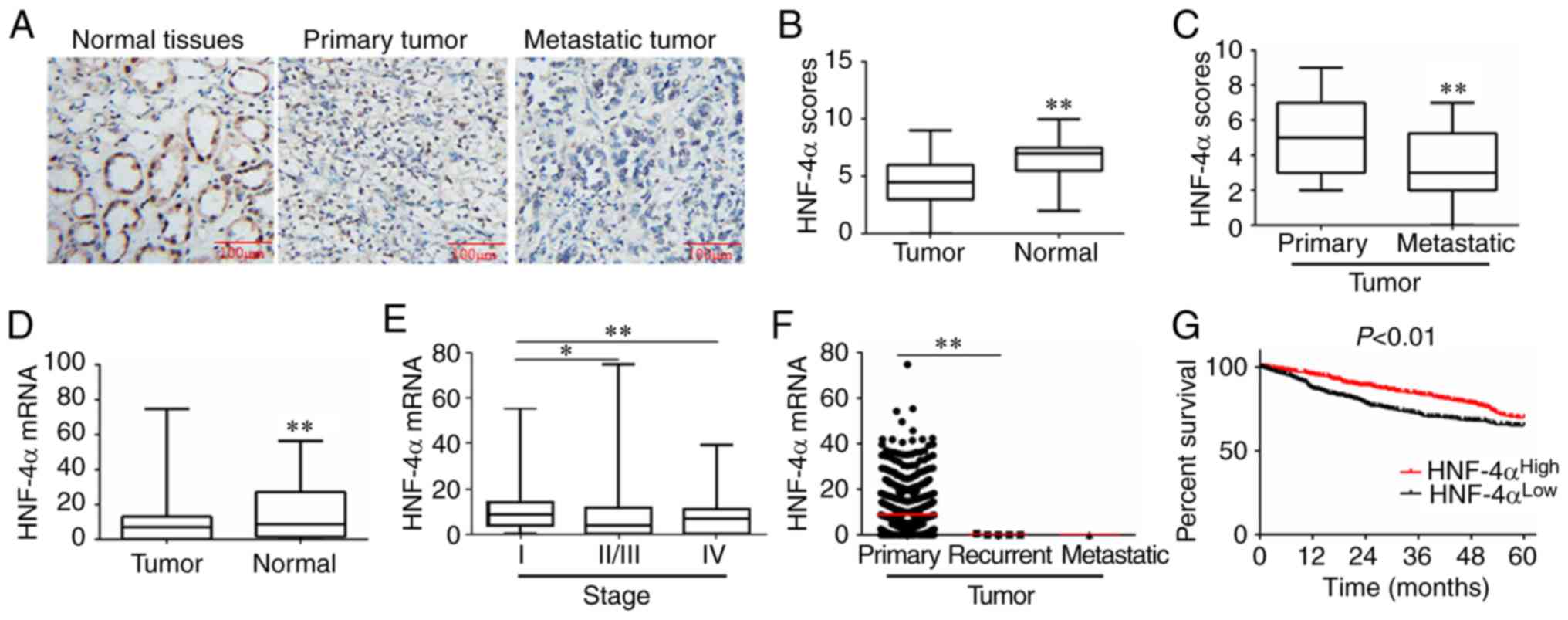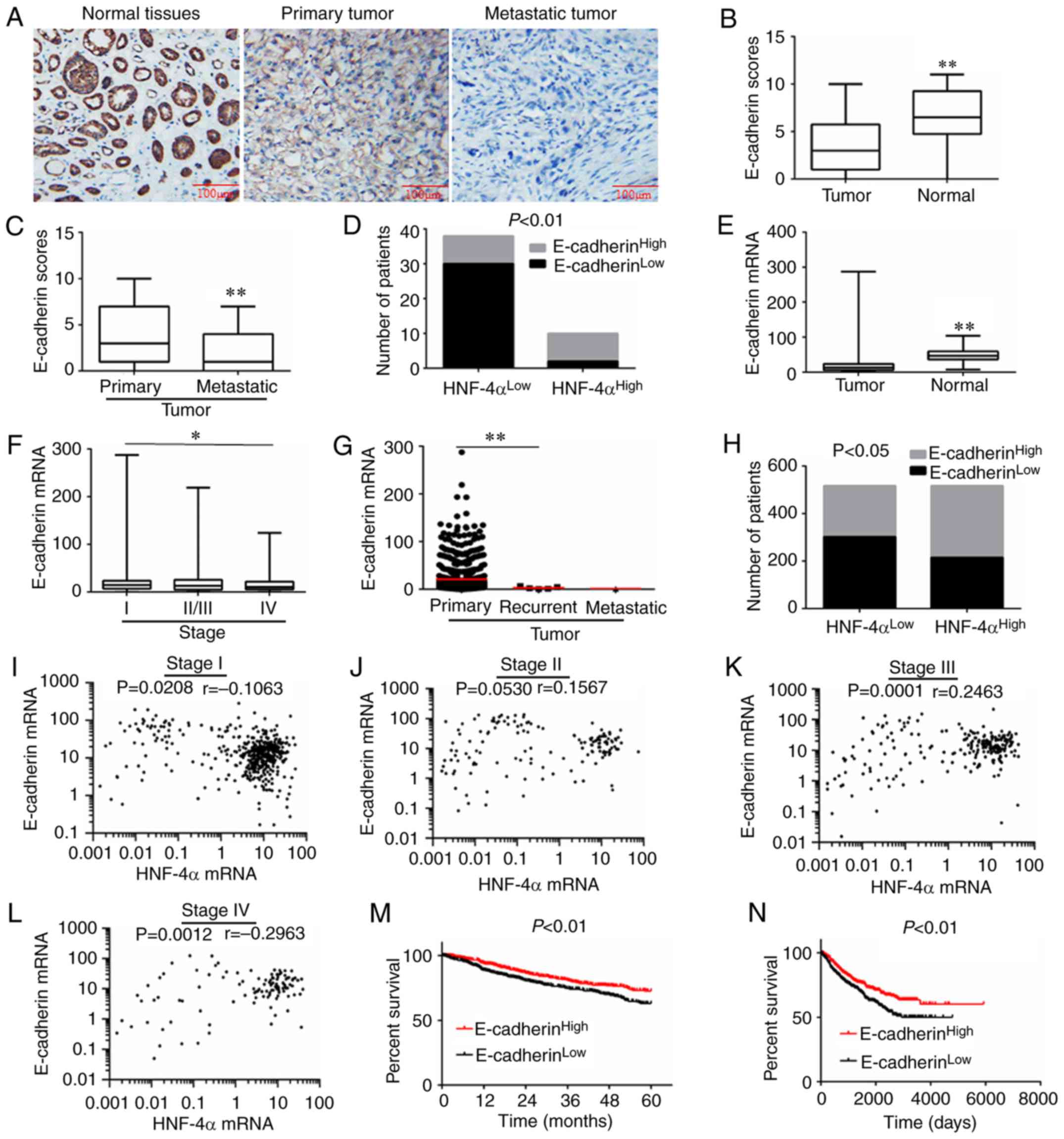|
1
|
Erickson LA: Clear cell renal cell
carcinoma. Mayo Clin Proc. 93:813–814. 2018. View Article : Google Scholar : PubMed/NCBI
|
|
2
|
Ljungberg B, Bensalah K, Canfield S,
Dabestani S, Hofmann F, Hora M, Kuczyk MA, Lam T, Marconi L,
Merseburger AS, et al: EAU guidelines on renal cell carcinoma: 2014
update. Eur Urol. 67:913–924. 2015. View Article : Google Scholar : PubMed/NCBI
|
|
3
|
Siegel RL, Miller KD and Jemal A: Cancer
statistics, 2016. CA Cancer J Clin. 66:7–30. 2016. View Article : Google Scholar : PubMed/NCBI
|
|
4
|
Kaelin WG Jr: Treatment of kidney cancer:
Insights provided by the VHL tumor-suppressor protein. Cancer. 115
(Suppl 10):S2262–S2272. 2009. View Article : Google Scholar
|
|
5
|
Gao YH, Wu ZX, Xie LQ, Li CX, Mao YQ, Duan
YT, Han B, Han SF, Yu Y, Lu HJ, et al: VHL deficiency augments
anthracycline sensitivity of clear cell renal cell carcinomas by
down-regulating ALDH2. Nat Commun. 8:153372017. View Article : Google Scholar : PubMed/NCBI
|
|
6
|
Ljungberg B, Campbell SC, Choi HY, Jacqmin
D, Lee JE, Weikert S and Kiemeney LA: The epidemiology of renal
cell carcinoma. Eur Urol. 60:615–621. 2011. View Article : Google Scholar : PubMed/NCBI
|
|
7
|
Chen S, Wang Q, Wang L, Chen H, Gao X,
Gong D, Ma J, Kubra S, Yao X, Li X, et al: REGgamma deficiency
suppresses tumor progression via stabilizing CK1epsilon in renal
cell carcinoma. Cell Death Dis. 9:6272018. View Article : Google Scholar : PubMed/NCBI
|
|
8
|
Lazarevich NL and Fleishman DI:
Tissue-specific transcription factors in progression of epithelial
tumors. Biochemistry (Mosc). 73:573–591. 2008. View Article : Google Scholar : PubMed/NCBI
|
|
9
|
Morimoto A, Kannari M, Tsuchida Y, Sasaki
S, Saito C, Matsuta T, Maeda T, Akiyama M, Nakamura T, Sakaguchi M,
et al: An HNF4alpha-microRNA-194/192 signaling axis maintains
hepatic cell function. J Biol Chem. 292:10574–10585. 2017.
View Article : Google Scholar : PubMed/NCBI
|
|
10
|
Battle MA, Konopka G, Parviz F, Gaggl AL,
Yang C, Sladek FM and Duncan SA: Hepatocyte nuclear factor 4alpha
orchestrates expression of cell adhesion proteins during the
epithelial transformation of the developing liver. Proc Natl Acad
Sci USA. 103:8419–8424. 2006. View Article : Google Scholar : PubMed/NCBI
|
|
11
|
Wang Z and Burke PA: Hepatocyte nuclear
factor-4alpha interacts with other hepatocyte nuclear factors in
regulating transthyretin gene expression. FEBS J. 277:4066–4075.
2010. View Article : Google Scholar : PubMed/NCBI
|
|
12
|
Stegmann A, Hansen M, Wang Y, Larsen JB,
Lund LR, Ritié L, Nicholson JK, Quistorff B, Simon-Assmann P,
Troelsen JT and Olsen J: Metabolome, transcriptome, and
bioinformatic cis-element analyses point to HNF-4 as a central
regulator of gene expression during enterocyte differentiation.
Physiol Genomics. 27:141–155. 2006. View Article : Google Scholar : PubMed/NCBI
|
|
13
|
Hayhurst GP, Strick-Marchand H, Mulet C,
Richard AF, Morosan S, Kremsdorf D and Weiss MC: Morphogenetic
competence of HNF4 alpha-deficient mouse hepatic cells. J Hepatol.
49:384–395. 2008. View Article : Google Scholar : PubMed/NCBI
|
|
14
|
Lazarevich NL, Shavochkina DA, Fleishman
DI, Kustova IF, Morozova OV, Chuchuev ES and Patyutko YI:
Deregulation of hepatocyte nuclear factor 4 (HNF4) as a marker of
epithelial tumors progression. Exp Oncol. 32:167–171.
2010.PubMed/NCBI
|
|
15
|
Lazarevich NL, Cheremnova OA, Varga EV,
Ovchinnikov DA, Kudrjavtseva EI, Morozova OV, Fleishman DI,
Engelhardt NV and Duncan SA: Progression of HCC in mice is
associated with a downregulation in the expression of hepatocyte
nuclear factors. Hepatology. 39:1038–1047. 2004. View Article : Google Scholar : PubMed/NCBI
|
|
16
|
Sel S, Ebert T, Ryffel GU and Drewes T:
Human renal cell carcinogenesis is accompanied by a coordinate loss
of the tissue specific transcription factors HNF4 alpha and HNF1
alpha. Cancer Lett. 101:205–210. 1996. View Article : Google Scholar : PubMed/NCBI
|
|
17
|
van Staalduinen J, Baker D, Ten Dijke P
and van Dam H: Epithelial-mesenchymal-transition-inducing
transcription factors: New targets for tackling chemoresistance in
cancer? Oncogene. 2018.(Epub ahead of print). View Article : Google Scholar : PubMed/NCBI
|
|
18
|
Devlin JR and Verschuren EW: More than a
tumor suppressor: E-cadherin loss drives lung cancer metastasis. Am
J Respir Cell Mol Biol. 59:141–142. 2018. View Article : Google Scholar : PubMed/NCBI
|
|
19
|
Kourtidis A, Lu R, Pence LJ and
Anastasiadis PZ: A central role for cadherin signaling in cancer.
Exp Cell Res. 358:78–85. 2017. View Article : Google Scholar : PubMed/NCBI
|
|
20
|
Livak KJ and Schmittgen TD: Analysis of
relative gene expression data using real-time quantitative PCR and
the 2(-Delta Delta C(T)) method. Methods. 25:402–408. 2001.
View Article : Google Scholar : PubMed/NCBI
|
|
21
|
Shen SM, Guo M, Xiong Z, Yu Y, Zhao XY,
Zhang FF and Chen GQ: AIF inhibits tumor metastasis by protecting
PTEN from oxidation. EMBO Rep. 16:1563–1580. 2015. View Article : Google Scholar : PubMed/NCBI
|
|
22
|
Yu D, An X, Fan W, Wang X, He Y and Li B:
PNUTS mediates ionizing radiation-induced CNE-2 nasopharyngeal
carcinoma cell migration, invasion, and epithelial-mesenchymal
transition via the PI3K/AKT signaling pathway. Onco Targets Ther.
12:1205–1214. 2019. View Article : Google Scholar : PubMed/NCBI
|
|
23
|
Min HJ, Lee Y, Zhao XF, Park YK, Lee MK,
Lee JW and Kim S: TMPRSS4 upregulates uPA gene expression through
JNK signaling activation to induce cancer cell invasion. Cell
Signal. 26:398–408. 2014. View Article : Google Scholar : PubMed/NCBI
|
|
24
|
Li X, Bao C, Ma Z, Xu B, Ying X, Liu X and
Zhang X: Perfluorooctanoic acid stimulates ovarian cancer cell
migration, invasion via ERK/NF-κB/MMP-2/-9 pathway. Toxicol Lett.
294:44–50. 2018. View Article : Google Scholar : PubMed/NCBI
|
|
25
|
Yao HH, Zhao YJ, He YF, Huang DB and Wang
W: Knockdown of AGGF1 inhibits the invasion and migration of
gastric cancer via epithelial-mesenchymal transition through
Wnt/beta-catenin pathway. Cancer Cell Int. 19:412019. View Article : Google Scholar : PubMed/NCBI
|
|
26
|
Chang Z, Cai C, Han D, Gao Y, Li Q, Feng
L, Zhang W, Zheng J, Jin J, Zhang H and Wei Q: Anoctamin5 regulates
cell migration and invasion in thyroid cancer. Int J Oncol.
51:1311–1319. 2017. View Article : Google Scholar : PubMed/NCBI
|
|
27
|
Batlle E, Sancho E, Franci C, Domínguez D,
Monfar M, Baulida J and García De Herreros A: The transcription
factor snail is a repressor of E-cadherin gene expression in
epithelial tumour cells. Nat Cell Biol. 2:84–89. 2000. View Article : Google Scholar : PubMed/NCBI
|
|
28
|
Prokop JW, Liu Y, Milsted A, Peng H and
Rauscher FJ III: A method for in silico identification of
SNAIL/SLUG DNA binding potentials to the E-box sequence using
molecular dynamics and evolutionary conserved amino acids. J Mol
Model. 19:3463–3469. 2013. View Article : Google Scholar : PubMed/NCBI
|
|
29
|
Moreno-Bueno G, Cubillo E, Sarrio D,
Peinado H, Rodríguez-Pinilla SM, Villa S, Bolós V, Jordá M, Fabra
A, Portillo F, et al: Genetic profiling of epithelial cells
expressing E-cadherin repressors reveals a distinct role for Snail,
Slug, and E47 factors in epithelial-mesenchymal transition. Cancer
Res. 66:9543–9556. 2006. View Article : Google Scholar : PubMed/NCBI
|
|
30
|
Spath GF and Weiss MC: Hepatocyte nuclear
factor 4 provokes expression of epithelial marker genes, acting as
a morphogen in dedifferentiated hepatoma cells. J Cell Biol.
140:935–946. 1998. View Article : Google Scholar : PubMed/NCBI
|














